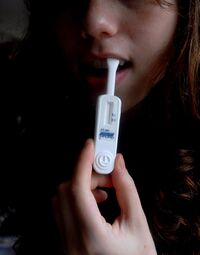Medicine:OraQuick
This article has multiple issues. Please help improve it or discuss these issues on the talk page. (Learn how and when to remove these template messages)
(Learn how and when to remove this template message)No issues specified. Please specify issues, or remove this template. |
 Demonstration of the OraQuick rapid HIV test | |
| Owner | OraSure Technologies |
|---|---|
| Introduced | 2012 |
| Website | oraquick |
OraQuick is an at-home HIV test manufactured by Orasure Technologies that was approved by the United States Food and Drug Administration in 2012.[1] It is one of only two at-home HIV tests available.[2] OraQuick can be purchased by anyone above aged 17 over-the-counter at any major retail stores or online.[1][3]
As of November 2018, the testing kit costs on average about $40-45. The United States Food and Drug Administration states that even though an individual can use the HIV test kit as a primary test measure, it is still important to see a medical professional for secondary testing.[1]
OraQuick measures the HIV antibodies in oral fluid, but not saliva.[4][5] The test kit contains an oral swab attached to the reader, and a fluid-filled test tube. The test results can either be invalid, positive, or negative.[6][7]
Principle
The OraQuick ADVANCE Rapid HIV-1/2 Antibody Test is a single-use, qualitative immunoassay that can be purchased over-the-counter (OTC). This test kit contains a test swab that collects oral fluid containing antibodies for HIV-1 and HIV-2 from the user’s gums. The material is gathered and combined with buffered developer solution in a test tube. After 20 to 40 minutes, the mixture moves up the test strip, and the findings are visible. The C-Line indicates that the mixture is migrating up the test strip adequately and the test is properly working. The T-Line contains antigens immobilized on a nitrocellulose membrane that HIV antibodies can react to. [8]
If a dark C-Line appears, then the test is working. The results are negative if only a C-Line is present. The results are positive if both a C-Line and T-Line appear.[5][8] Since a positive result does not necessarily indicate HIV-positive status, a follow-up test should be done in a medical setting to confirm the test results.[9] An initial positive result is not a definitive HIV diagnosis, but rather it should prompt the user to seek immediate medical attention for HIV blood tests and follow-ups.[4][5] A negative result indicates no HIV infection, but the test cannot accurately detect HIV levels when exposure was within the past 3 months. Even then, there can still be false negatives.[1]
Accuracy
Testing performance
In a clinical study, trained professionals compared HIV test results of OraQuick In-Home HIV Test with results from laboratory testing. The study was conducted on 4,999 participants and found OraQuick testing correctly generated a negative result 4,902 times out of the 4,903 times laboratory testing generated a negative result (99.9%).[7] OraQuick testing generated a positive result 88 times out of 96 times that laboratory testing generated a positive result (91.7%). [7] Researchers saw subjects failed to obtain any test result 56 times in 5,055 instances (1.1%).[7] OraQuick In-Home HIV Testing is expected to provide accurate results at 3 months from exposure since this is the amount of time it takes for people to develop antibodies to HIV.[10] A negative test result does not confirm individuals are not infected by HIV. There is a window period of approximately 3 months when individuals are still not producing enough antibodies to generate a positive result, thus it is recommended to test regularly. [10]
False positives
Lyme disease, syphilis, lupus, and other conditions can contribute to false positive results.[10]
False negatives
Testing too soon after exposure (window period), low antibody levels, antiviral therapy, and testing within 30 minutes of eating or drinking can all contribute to false negative results.[10]
References
- ↑ 1.0 1.1 1.2 1.3 Research, Center for Biologics Evaluation and. "Consumer Updates - First Rapid Home-Use HIV Kit Approved for Self-Testing" (in en). https://www.fda.gov/ForConsumers/ConsumerUpdates/ucm310545.htm.
- ↑ "Home Tests | HIV Testing | HIV/AIDS | CDC" (in en-us). 2017-03-21. https://www.cdc.gov/hiv/testing/hometests.html.
- ↑ "Where to Buy OraQuick In Home HIV Test Kits". http://www.oraquick.com/where-to-buy.
- ↑ 4.0 4.1 "HIV Testing | HIV/AIDS | CDC" (in en-us). 2018-06-26. https://www.cdc.gov/hiv/testing/index.html.
- ↑ 5.0 5.1 5.2 "How Oral HIV Testing Works | OraQuick In Home HIV Test". http://www.oraquick.com/What-is-OraQuick/How-Oral-Testing-Works.
- ↑ "OraQuick Video for In Home HIV Test Kit". http://www.oraquick.com/Taking-the-Test/How-To-Video.
- ↑ 7.0 7.1 7.2 7.3 "OraQuick Results for In Home HIV Testing". http://www.oraquick.com/Taking-the-Test/Understanding-Your-Results.
- ↑ 8.0 8.1 "Package Insert - OraQuick ADVANCE Rapid HIV-1/2 Antibody Test, OraSure Technologies", "US Food and Drug Administration", Retrieved 2018-11-01
- ↑ "Information regarding the OraQuick In-Home HIV Test", US Food and Drug Administration, Retrieved 2018-11-01
- ↑ 10.0 10.1 10.2 10.3 "HIV FAQ | OraQuick Home HIV Test". http://www.oraquick.com/FAQs.
External links
 |

